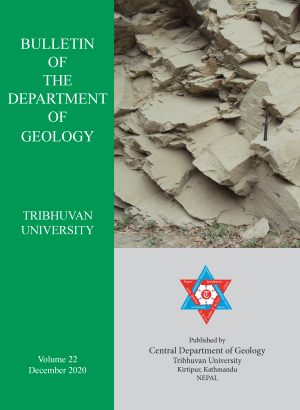Geology of Shantipur-Wami Taksar Areas of Gulmi-Baglung Districts, Western Nepal
DOI:
https://doi.org/10.3126/bdg.v22i0.33412Keywords:
Badi Gad Fault, back thrust, copper and iron mineralizationAbstract
The study area represents a small part of the Lesser Himalaya in western Nepal and lies about 346 km west from Kathmandu. It covers 250 km area representing some parts of Gulmi and Baglung districts. The area was selected for the present study on the impression from the previous geological map that has showed some metallic mineral resources like iron, copper and lead in the region. Similarly, studies reveal that there is very complicated geological structure which raised the interest for the study. Main objective of the study was to prepare a geological map of the area in a scale of 1:25,000 and study the possible mineral deposits. An extensive geological mapping was carried out in the field covering at one data within one centimetre of the map scale and large number of samples was collected for the petrographic as well as ore genesis studies. The rocks of the region were mapped under two geological units as the Nourpul Formation (older) and the Dhading Dolomite (younger). There are a series of folds in the area. From regional to micro-scale all folds are trending towards east-west. The Badi Gad Fault and the Harewa Khola Thrust are the regional scale thrust mapped in the area. The Badi Gad is considered as a strike-slip in nature. The Harewa Khola Thrust is probably an imbricate fault. It has propagated to the north which is out of sequence in nature.
Some metallic minerals like copper and iron along with old working mines were observed during the study. Occurrences of copper and iron mineralization has been mapped and described. Present study revealed that copper mineralization is limited within the veins and boudinage forms as hydrothermal deposit while the iron is tabular and syngenetic in nature.
Downloads
Downloads
Published
How to Cite
Issue
Section
License
© Central Department of Geology, Tribhuvan University, Nepal

